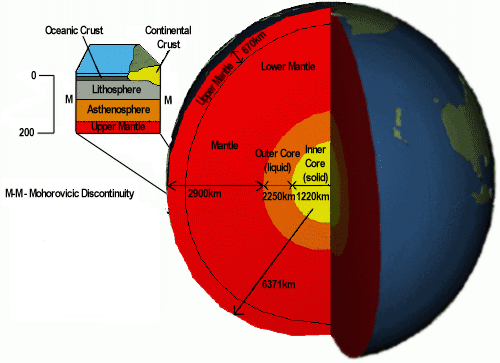♥Troposphere♥
| Troposphere | Structure of the Earth's Atmosphere : Troposphere |
Troposphere The troposphere is the atmospheric layer closest to the planet and contains the largest percentage of the mass of the total atmosphere. It is characterized by the density of its air and an average temperature decrease with height ( lapse rate ) of 6 oC per kilometer.
Temperature and water vapour content in the troposphere decrease rapidly with altitude. Water vapour plays a major role in regulating air temperature because it absorbs solar energy and thermal radiation from the planet's surface. The troposphere contains 99 % of the water vapour in the atmosphere. Water vapour concentrations vary with latitudinal position(i.e. North to South). They are greatest above the tropics, where they may be as high as 3 %, and decrease toward the polar regions.
All weather phenomena occur within the troposphere, although turbulence may extend into the lower portion of the stratosphere. Troposphere means "region of mixing" and is so named because of vigorous convective air currents within the layer.
The boundary between the troposphere, and the stratosphere is called the tropopause. The height of the tropopause from the ground ranges from 8 km in high latitudes, to 18 km above the equator. Its height also varies with the seasons; highest in the summer and lowest in the winter. Air temperature within the tropopause remains constant with increasing altitude. The tropopause is a boundary layer defined by a sudden change in lapse rate.
♥Stratosphere♥
| Stratosphere | The structure of the Earth's atmosphere: Stratosphere |
Stratosphere The stratosphere is the second major stratus (layer) of air in the atmosphere. It resides between 10 and 50 km above the planet's surface. The air temperature in the stratosphere remains relatively constant up to an altitude of 25 km. Then it increases gradually to 470-490 oC at the boundary with mesosphere, the stratopause ( which is at a height of ~50 km). The boundary is marked by a decrease in temperature. Because the air temperature in the stratosphere increases with altitude, it does not cause convection and has a stabilising effect on atmospheric conditions in the region.
Ozone plays the major role in regulating the thermal regime of the stratosphere, since water vapor content within the layer is very low. The ozone absorbs the sun's ultraviolet radiation and warms up, therefore temperature increases with ozone concentration.
♥Mesosphere♥
| Mesosphere | The structure of the Earth's atmosphere: Mesosphere |
Mesosphere The temperature decreases once more as we go through the mesosphere, which is the layer between 50 and 80 km. The temperatures in this layer reach 190-180 K (-83 to -93 0C)at an altitude of 80 km. In this region, concentrations of ozone and water vapor are negligible. Hence the temperature is lower than that of the troposphere or stratosphere. With increasing distance from Earth's surface the chemical composition of air becomes strongly dependent on altitude and the atmosphere becomes enriched with lighter gases. At very high altitudes, the gases begin to form into layers according to molecular mass (weight), because the force of gravity is greater on the heavier molecules. It is in this layer that foreign bodies (such as meteors and spacecraft) entering the atmosphere start to warm up.
♥thermosphere♥
| Thermosphere | The structure of the Earth's atmosphere: Thermosphere |
Thermosphere The thermosphere is located above the mesosphere and is separated from it by the mesopause transition layer. The temperature in the thermosphere generally increases with altitude up to 1000-1500 K. This increase in temperature is due to the absorption of intense solar radiation by the limited amount of remaining molecular oxygen. At an altitude of 100-200 km, the major atmospheric components are still nitrogen and oxygen. At this extreme altitude gas molecules are widely separated. It is within the thermosphere that the aurora phenomena may be observed.
♥Ionosphere♥
The Ionosphere
 This absorption of radiation is also responsible for the Ionosphere. Located within the thermosphere, the ionosphere is made of electrically charged gas particles (ionized). The ionosphere extends from 37 to 190 miles (60-300 km) above the earth's surface. It is divided into three regions or layers; the F-Region, E-Layer and D-layer. During the daytime the F-Layer splits into two layers and recombines at night.
This absorption of radiation is also responsible for the Ionosphere. Located within the thermosphere, the ionosphere is made of electrically charged gas particles (ionized). The ionosphere extends from 37 to 190 miles (60-300 km) above the earth's surface. It is divided into three regions or layers; the F-Region, E-Layer and D-layer. During the daytime the F-Layer splits into two layers and recombines at night.
The E-layer was discovered first. In 1901, Guglielmo Marconi transmitted a signal between Europe and North America and showed that it had to bounce off an electrically conducting layer about 62 miles (100 km) altitude. In 1927, Sir Edward Appleton named that conducting layer the (E)lectrical-Layer. Later, discovery of additional conducting layers were simply called the D-layer and F-Layer.
Since the ionosphere existance is due to radiation from the sun striking the atmosphere, it changes in density from daytime to nighttime. All three layers are more dense during the daytime. At night, all layers decrease in density with the D-Layer undergoing the greatest change. At night the D-Layer essentially disappears.
As seen around the 1900's, the ionosphere has the important quality of bouncing radio signals transmitted from the earth. Its existance is why places all over the world can be reached via radio.

As the radio signal is transmitted, some of the signal will escape the earth through the ionosphere (green arrow). The ground wave (purple arrow) is the direct signal we hear on a normal basis. This wave weakens quickly and is what one hears as a fading signal.
The remaining waves (red and blue arrows) are called "skywaves." These waves bounce off the ionosphere and can bounce for many 1000's of miles depending upon the atmospheric conditions.
♥Litosphere♥
Lithosphere
The outer, rigid shell of the earth. It is composed of the entire crust and uppermost part of the mantle. The thickness of the lithosphere varies from around 5km to up to 100km where there is thick continental crust. The lithosphere is above the more ductile asthenosphere. The boundary between these two layer is the Mohorovicic discontinuity.
The lithosphere is fragmented into tectonic plates which move relative to one another. This movement of lithospheric plates is described as plate tectonics.

Hydrosphere

The hydrosphere includes all water on Earth. In one respect, planet Earth is a misnomer in that 71% of the earth is covered by water and only 29% is terra firma. Indeed, the abundance of water on Earth is a unique feature that clearly distinguishes our "Blue Planet" from others in the solar system. Not a drop of liquid water can be found anywhere else in the solar system. It is because the Earth has just the right mass, the right chemical composition, the right atmosphere, and is the right distance from the Sun (the "Goldilocks" principle) that permits water to exist mainly as a liquid. However, the range of surface temperatures and pressures of our planet permit water to exist in all three states: solid (ice), liquid (water), and gas (water vapor). Most of the water is contained in the oceans and the high heat capacity of this large volume of water (1.35 million cubic kilometers) buffers the Earth surface from large temperature changes such as those observed on the moon. Water is the universal solvent and the basis of all life on our Planet. It is an essential life-sustaining resource which led Benjamin Franklin to comment "When the well's dry, we know the worth of water."
Links to other components:
Water cycles between the various components of the Earth system via the hydrologic cycle.
Atmosphere: Water is transferred between the hydrosphere and biosphere by evaporation and precipitation. Energy is also exchanged in this process.
Biosphere: Terrestrial plants withdraw water from the ground using their root systems and transport water and nutrients through the vascular system to stems and leaves. Evaporation of water from the leaf surface (called transpiration) is effective at transferring water to the atmosphere.
Geosphere: Water is the primary agent for the chemical and mechanical breakdown of rock, called weathering, to form loose rock fragments (regolith) and soil. By the process of erosion, water sculpts the surface of the Earth as precipitation that falls on the land makes it way by to the sea. The geomorphology of the Earth is unique because of running water. Runoff channels on Mars suggest that it had free-flowing water early in its history when climate was warmer.
Anthrosphere: Human activity has significantly impacted the supply and quality of water on Earth through our agricultural and industrial practices. Chemical contamination of groundwater, lakes, rivers, and the oceans is threatening the quality of the water supply in many parts of the world.



No comments:
Post a Comment